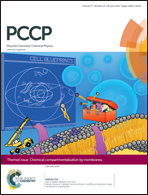Ab initio study of the O4H+ novel species: spectroscopic fingerprints to aid its observation
Abstract
A detailed ab initio characterization of the structural, energetic and spectroscopic properties of the novel O4H+ species is presented. The equilibrium structures and relative energies of all multiplet states have been determined systematically by analyzing static and dynamical correlation effects. The two and three body dissociation processes have been studied and indicate the presence of conical intersections in various states including the ground state. Comparison with available thermochemical data is very good, supporting the applied methodology. The reaction, H3+ + O4 → O4H+ + H2, was found to be exothermic ΔH = −19.4 kcal mol−1 and therefore, it is proposed that the product in the singlet state could be formed in the interstellar medium (ISM) via collision processes. To aid in its laboratory or radioastronomy detection in the interstellar medium we determined spectroscopic fingerprints. It is estimated for the most stable geometry of O4H+ dipole allowed electronic transitions in the visible region at 429 nm and 666 nm, an intense band at 1745 cm−1 in the infrared and signals at 40.6, 81.2 and 139.2 GHz in the microwave region at 10, 50 and 150 K respectively, relevant for detection in the ISM.


 Please wait while we load your content...
Please wait while we load your content...